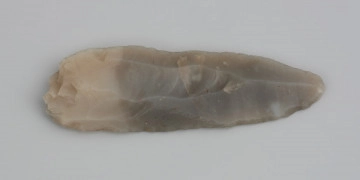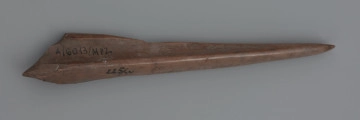
Single-jagged edge
11900 p.n.e. — 11000 p.n.e.
National Museum in Szczecin
Part of the collection: Stone Age
A Federmesser-type backed blade was found in Morzyczyn, the Stargard district, in June 1904 during a search conducted by Dr Wunstorf, a geologist from Berlin. In the 1930s, the search in Morzyczyn was conducted by R. Richter, an amateur archaeologist from Szczecin, interested primarily in the Stone Age. The backed blade comes from the collection of the former Gesellschaft für Pommersche Geschichte und Altertumskunde. It was made from a half blade, i.e., an elongated fragment of an enormous lump of local chalk flint of very high quality struck with a soft pestle from bone or antler. However, too strong blows caused part of the blade to break off. Forming the shape of the tool involved the so-called flaking, bouncing small parts off the edge with bone or antler in such a way as to produce a sharp tip and blunt butt. Such items were usually used as spearheads, javelins and arrows, in some cases also as knives. The backed blade from Morzyczyn was also used as a piercing tool. It is evidenced by characteristic marks, the so-called shining on the tip. Alteration of tools and using them for different activities is typical of hunter-gatherer communities in the Late Palaeolithic and Mesolithic. The backed blade should be associated with the Federmesser culture, whose name derives from the characteristic feather-shaped blades (German Feder - feather, Messer - blade). The people of this culture inhabited diverse ecological niches, from the tundra, through park tundra to birch-pine forests. Hunting was adapted to local environmental conditions and included hunting large mammals such as moose and reindeer, supplemented by hunting small mammals, birds and fish. It is generally dated to c. 11900-11000 BC.
Michał Adamczyk
Other names
arched backed blade
Author / creator
Dimensions
cały obiekt: height: 6.2 cm, width: 1.6 cm
Object type
backed point
Technique
carving, peeling, soft masher carving
Material
flint, stone
Origin / acquisition method
acquisition
Creation time / dating
Creation / finding place
Owner
National Museum in Szczecin
Identification number
Location / status

11900 p.n.e. — 11000 p.n.e.
National Museum in Szczecin

11900 p.n.e. — 11000 p.n.e.
National Museum in Szczecin

9600 p.n.e. — 4100 p.n.e.
National Museum in Szczecin
DISCOVER this TOPIC
National Museum in Szczecin
DISCOVER this PATH
Educational path